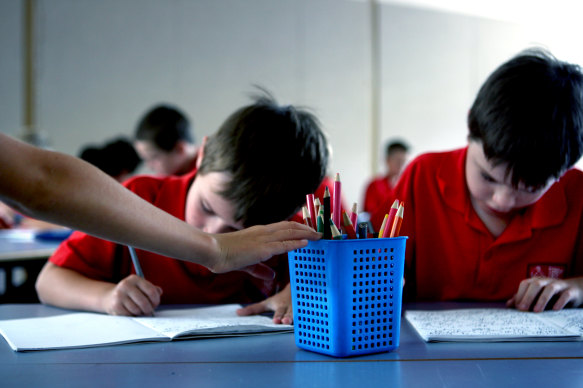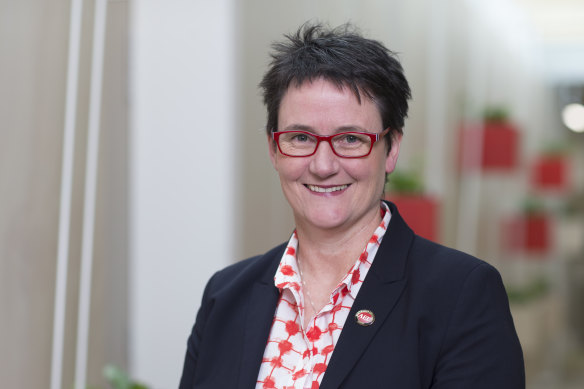By Bridie Smith
Parents could be forced to juggle more pupil-free days as the state’s teachers flag a push for a better deal that could include more time out of the classroom.
More than 1600 state schools will be closed to students on Monday before the Melbourne Cup public holiday, meaning students will be in the classroom for just three days this week.

Many students will have Monday as a school-free day before the Melbourne Cup public holiday.Credit: Louise Kennerley
Victoria’s teachers currently get five pupil-free days under their agreement, which is due to expire next year. But the state government could face an emboldened push by teachers after their NSW counterparts secured an additional three pupil-free days each year.
In a deal struck last week, NSW teachers will get eight pupil-free days for preparation and planning.
Since the Victorian agreement was signed in 2022, the profession has had to deal with significant changes, including to the maths curriculum for prep to year 10 students and the introduction of a structured phonics method to teach prep to grade 2 students to read.
Both changes required additional training and planning for schools and staff.
“We will look to the NSW agreement,” Australian Education Union Victorian president Meredith Peace confirmed. “All of our AEU branches look very closely at what other [interstate] branches are achieving and what we might be able to try and achieve ourselves.”

The Australian Education Union’s Meredith Peace says workload will need to be addressed when negotiations start with government next year.
Under the Victorian Government Schools Agreement, school councils can schedule up to five student-free days a year for professional development or student assessment and reporting, including an optional professional practice day. Schools can choose how they use two of these days.
The pupil-free days are in addition to Victoria’s public holidays, four of which – Labour Day, Anzac Day, King’s Birthday and Melbourne Cup – fall within term time next year.
The union will begin developing its log of claims within months and will present them to the government by mid-year when negotiations formally start.
“We’ve had claims in previous agreements around increased numbers of pupil-free-days, and the government has always rejected that,” Peace said.
Instead, the current Victorian Government Schools Agreement granted teachers a reduction of 90 minutes of face-to-face time each week to be used for preparation and planning and time-in-lieu for parent-teacher interviews, camps and information nights.
But Peace said the unpaid work being done remained “a significant problem” and needed to be addressed.
She said principals did an average of 17.5 hours a week of unpaid work, while for teachers it was about 12.4 hours – much of that involving compliance and administration work.
Parents Victoria chief executive Gail McHardy said if Victoria was to follow NSW and increase the number of pupil-free days in a future bargaining agreement, parents would need to be clear on why there had been a change.
“If it’s clear that it’s being increased to assist workforce issues and families will be given advance notice ... that would be a positive step,” she said.
Among parents’ main gripes surrounding schools’ pupil-free days are poor communication and a lack of advance warning.
McHardy said schools needed to show respect to families and give them notice to enable them to plan for a change in routine.
Parents with multiple children at a number of schools faced the added challenge of juggling different pupil-free days, she said.
“The challenge increases if the pupil-free days are different. So where school networks can collaborate, that’s helpful.”
La Trobe University dean of education Professor Joanna Barbousas said pupil-free days served a purpose as schools were keen to adopt new practices, but teachers needed time to prepare before entering the classroom.
“Pupil-free days give schools time to retrain and understand new teaching methodologies, sharing knowledge and best practice with those that have already made the transition,” she said.
Barbousas acknowledged that accountability was important when it came to how the days were used.
A state government spokesperson pointed to the $10.7 million it allocated to reduce the time that school staff spend on administration, including support for teachers in curriculum and assessment planning.
The spokesperson said that schools could use the pupil-free days to prepare for the introduction of phonics into the prep to grade 2 curriculum next year and that teachers would be provided with a set of ready-to-use resources to help the transition.
“Victoria is home to some of the most talented teachers in the nation, and we’re backing them with the resources they need,” the spokesperson said.
Start the day with a summary of the day’s most important and interesting stories, analysis and insights. Sign up for our Morning Edition newsletter.